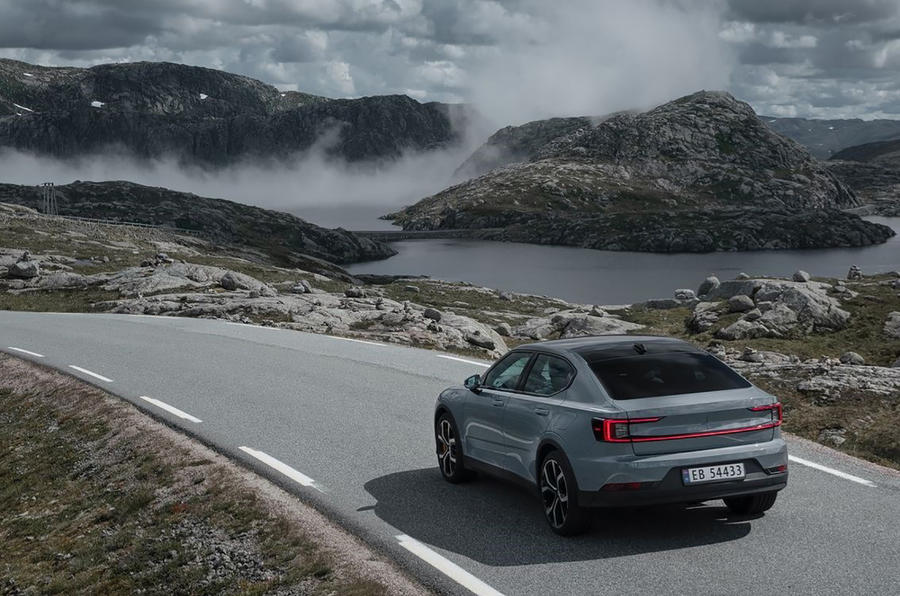While much of the world has been plotting routes to EV adoption, Norway – oil-rich enough to incentivise like crazy and awash with clean energy solutions thanks to its geography (renewable sources supply 98% of its energy) – has been cracking on. So much so that some analysts are now running trend graphs that suggest it might sell its final pure-ICE car in the first half of 2022.
While that seems fanciful, given how hard it is to force a figure from very low to zero, 95% of the 110,000 new vehicles registered in Norway in the first half of this year were hybrid, plug-in hybrid or electric.
While hybrids represent a loophole (the electricity being sourced by burning petrol and providing but a thimbleful of assistance), they don’t actually change the status quo too much. Of the 15 best-selling models in Norway, 14 are EVs, and the only interloper is the second-placed Toyota RAV4 PHEV. The highest-placed hybrid is the Toyota Corolla in 16th and the highest-placed diesel is the Volkswagen Tiguan in 28th – one of just three in the top 50.
Almost 75% of cars sold in Norway in 2020 had a plug socket, and whatever happens between now and the end of this year, that number will soar again. In a country with famously challenging (and, notably, battery-sapping) weather and where travelling long distances is common, it’sinteresting how readily car buyers have switched to EVs.
How so? A holistic approach driven hard by incentives seems to be the answer. Buying or leasing an EV in Norway means paying reduced purchase tax, VAT and VED. Company car drivers get significant subsidies, too. Meanwhile, all road tolls and public parking charges are reduced by law and EV owners can use bus and taxi lanes. And more than 16,000 charging stations have been built – about 10% of Europe’s total, despite Norway having less than 1% of its population.
Norway has challenges to overcome still, most significantly managing all ICE cars off its roads. For all its success in selling new electrified vehicles, only around 20% of its car parc is plug-in. Globally, the average vehicle life is about 14 years, but of course averages include numbers that are both higher and lower. A 30-year run-down is anticipated in Norway.
But if getting there is hard, getting there first is harder still. Somewhere between six and eight years ago, Norway had a similar share of plug-in cars to the UK’s today – and buyers had far fewer and much less capable cars to choose from.
Will we achieve the same in the same time span? It’s unlikely, considering our government has invested and incentivised less and set an ICE deadline nine years away. But Norway has shown what’s possible.






Join the debate
Add your comment
The Norwegian Govt are a bunch of hypocrites. They have the worlds biggest pension fund based entirely on Oil revenues. They have renewable energy from Hydro . They have a small highly taxed compliant population and by giving .huge EV bonuses financial and social have got the population to buy these vehicles. They won't have range anxiety as they have no range to go ! All Together a bit of a con which is why the EV people quote Norway all the time . I'll be long gone before this all plays out as a great way of redistributing wealth . Watch COP21 as part of the charade. Remember when the wind don't blow and the sun don't shine you either go nuclear coal or gas from Putin , good luck . He doesn't give a monkey about it all.
The Norwegian Govt are a bunch of hypocrites. They have the worlds biggest pension fund based entirely on Oil revenues. They have renewable energy from Hydro . They have a small highly taxed compliant population and by giving .huge EV bonuses financial and social have got the population to buy these vehicles. They won't have range anxiety as they have no range to go ! All Together a bit of a con which is why the EV people quote Norway all the time . I'll be long gone before this all plays out as a great way of redistributing wealth . Watch COP21 as part of the charade. Remember when the wind don't blow and the sun don't shine you either go nuclear coal or gas from Putin , good luck . He doesn't give a monkey about it all.
A casual glance at the sales figures reinforces the commonly held viewed of environmentally-correct Norway as the world’s most electric-car friendly country. Given the tax breaks, it’s no surprise.
Why would you buy anything but electric when they are free of Norway’s 25percent import duty; nor do they pay the annual road tax; local parking is free, company car tax is reduced by 40percent, and they can access bus lanes?
How can Norway afford to subsidise electric car sales so heavily? The answer reveals the country’s great hypocrisy.
Norway can afford electric cars because it has developed the world’s largest sovereign fund – now at 960 billion pounds – by selling, and saving, most of the proceeds from of its share of the vast North Sea oil and gas reserves. The Norwegians may not be creating emissions at home, but it seems acceptable to them that the energy they sell - primarily to China, Sweden, The Netherlands and UK - is creating greenhouse gas emissions elsewhere. Virtuous Norway? Not really, more pragmatic Norway.
Yes, Norway is moving to develop hydrogen and offshore wind but it plans to continue to extract oil and gas until at least 2050, though the Government does say there will be a natural 65percent decline by then. This policy runs counter to a recent appeal by the International Energy Agency for all countries to stop investing in any new oil or gas projects by 2022.
Peter Robinson, Sydney, Australia